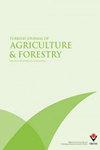向日葵(Helianthus annuus L.)品种/杂交耐热性的生长和生理生化指标筛选
IF 3
2区 农林科学
Q1 AGRONOMY
引用次数: 0
摘要
高温可能导致树枝和叶子烧焦,并伴有晒伤、叶片衰老、生长抑制等视觉症状,最终导致植物生长和生物量下降。向日葵(Helianthus annuus L.)是巴基斯坦重要的油料作物之一,在农业系统和石油生产部门具有潜在的应用价值。因此,重要的是要得到最好的品种,可以在炎热和潮湿的环境中忍受高温。为此,我们在对照(25°C)和热胁迫(45°C)两种不同温度的生长室内,对10个不同品种(Hysin-33、T-40、H-OI、Hysin-39、Suncross、Gulshin、FH-825、FH-797、FH-784、AGSUN-5270)的H. annuus进行了研究。采用盆栽试验,将营养砂培养基置于生长室受控环境中培养4周。结果表明:热胁迫显著(p < 0.05)降低了黄酮和酚类物质含量,增加了丙二醛(MDA)和过氧化氢(h2o2)浓度,增加了活性氧(ROS)的生成,降低了茎长、根长、茎鲜重、根鲜重、茎干重、根干重、叶绿素a、叶绿素b、总叶绿素和类胡萝卜素含量。Hysin-39、FH-825和Hysin-33在热胁迫条件下生长发育较好,属于耐热品种;Gulshin、Suncross和AGSUN-5270在相同的胁迫条件下生长发育较差,属于热敏感品种。高温胁迫下黄参品种的总体趋势为:Hysin-39 > FH-825 > Hysin-33 > T-40 > H-OI > FH-784 > FH-797> AGSUN-5270 > Suncross > Gulshin。本文章由计算机程序翻译,如有差异,请以英文原文为准。
Screening of sunflower (Helianthus annuus L.) cultivars/hybrids for heat stress tolerance using growth and physiobiochemical indicators
: High temperatures may cause scorching of the twigs and leaves along with visual symptoms of sunburn, leaf senescence, growth inhibition, and ultimately decreased plant growth and biomass. Sunflower ( Helianthus annuus L.) is one of the important oil seed crops and it potentially fits in agricultural system and oil production sector of Pakistan. Hence, it is important to get the best variety which may able to tolerate high temperatures in hot and humid environments. For this purpose, we have conducted the present study using ten different cultivars of (Hysin-33, T-40, H-OI, Hysin-39, Suncross, Gulshin, FH-825, FH-797, FH-784, AGSUN-5270) of H. annuus grown in the growth chambers in two different temperatures, i.e. control (25 °C) and heat stress (45 °C). A pot experiment was conducted and contains nutritional sand medium in the controlled environment in the growth chamber for 4 weeks. Results from the present study showed that heat stress induced a significant (p < 0.05) decrease in shoot length, root length, shoot fresh weight, root fresh weight, shoot dry weight, root dry weight, chlorophyll a, chlorophyll b, total chlorophyll, and carotenoid content while increasing the production of reactive oxygen species (ROS) by increasing the concentration of malondialdehyde (MDA) and hydrogen peroxide (H 2 O 2 ), which is manifested by increasing content of flavonoid and phenolic. Results also showed that Hysin-39, FH-825, and Hysin-33 showed better growth and development in heat-stressed environment and considered a heat-tolerant cultivar while Gulshin, Suncross, and AGSUN-5270 showed poor growth and development in the same stressed environment and were considered heat-sensitive cultivars. The overall trend of H. annuus cultivars grown under heat stress is as follows: Hysin-39 > FH-825 > Hysin-33 > T-40 > H-OI > FH-784 > FH-797> AGSUN-5270 > Suncross > Gulshin.
求助全文
通过发布文献求助,成功后即可免费获取论文全文。
去求助
来源期刊
CiteScore
4.20
自引率
6.90%
发文量
42
审稿时长
12 months
期刊介绍:
The Turkish Journal of Agriculture and Forestry is published electronically 6 times a year by the Scientific and Technological Research Council of Turkey (TÜBİTAK).
It publishes, in English, full-length original research papers and solicited review articles on advances in agronomy, horticulture, plant breeding, plant protection, plant molecular biology and biotechnology, soil science and plant nutrition, bionergy and energy crops, irrigation, agricultural technologies, plant-based food science and technology, forestry, and forest industry products.

 求助内容:
求助内容: 应助结果提醒方式:
应助结果提醒方式:


